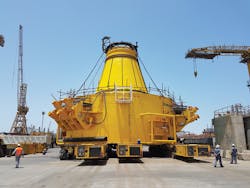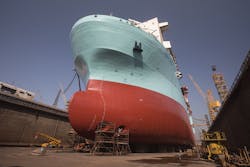Lancaster EPS to address basement flow uncertainties west of Shetland
Jeremy Beckman
Editor, Europe
Positive results could widen development of neglected play
Preparations are advancing for the early production system (EPS) for the Lancaster oilfield, operated by Hurricane Energy. The field, located in the west of Shetland region of the UK continental shelf (UKCS), will be the first sustained attempt to produce oil from a fractured basement reservoir in northwest Europe. The project is due to reach first oil during the first half of 2019.
A number of the offshore building blocks are coming together ahead of the arrival of the FPSO Aoka Mizu. Most recently, the company announced the Transocean’s semisubmersible Paul B. Loyd Jr. had successfully re-entered and completed two suspended wells for the development as producers.
Schematic of Lancaster EPS field layout. (All images courtesy Hurricane Energy)
Hurricane aims to use the data to fine-tune planning for a full development of the Lancaster field, which has estimated recoverable resources of more than 520 MMbbl. A successful outcome could spur more widespread appraisal and development of the untapped basement potential in the area, including the nearby Halifax and Lincoln discoveries, both potential giants which may form part of the same development as Lancaster. Offshore spoke to Hurricane CEO Dr. Robert Trice about the background to the EPS and the company’s goals for the forthcoming campaign.
Offshore: Does Hurricane’s team have prior experience working on other basement field developments west of Shetland or elsewhere?
Trice: I myself worked for both Enterprise Oil and Shell on fractured reservoirs from Italy, Greece, Oman, Norway, and the UK and became particularly interested in fractured basement through my involvement in a fractured basement play in Vietnam. This experience was heightened further when working subsequently on the Clair field west of Shetland for both Enterprise and Shell. Clair produces from a sandstone reservoir which is underlain by a thick fractured and oil-bearing basement interval. Whilst Hurricane’s geoscience team had no direct experience of basement reservoirs prior to joining the company, the company does employ specialist consultants that have direct experience of fractured basement reservoirs.
Offshore: For its exploration program over the past few years, has Hurricane drawn analogies with other basement plays?
Trice:There are numerous fractured basement play examples around the world, many of which exhibit characteristics similar to the west of Shetland basement. For example, a) most basement fields form buried hill traps, or combination traps with faults; b) basement reservoirs owe their high production rates to fault zones or specific faults identified from seismic data; and c) basement reservoirs are also associated with fractures the flow properties of which have been enhanced by diagenetic processes associated with near-surface weathering or deep hydrothermal activity. By learning from these analogues, in particular how they have been successfully developed, Hurricane is executing a development plan designed to optimize reservoir performance through the use of horizontal drilling integrated with 3D seismic surveys and by ensuring that well rates are designed to mitigate against aquifer ingress.
The Paul B. Loyd Jr. on location.
Despite these analogies, there is no direct analogue to Lancaster. Lancaster has a uniquely highly connected fracture network which results in very high flow rates and the associated high Productivity Indices (PIs). The quality of the fracture network at Lancaster, and we believe the West of Shetland Rona Ridge basement play, is attributed to the age of the reservoir (2.4 billion years) and the associated geological history of the reservoir’s structural evolution. The proximity of the reservoir to the Atlantic Margin is of particular significance – the process of Mesozoic extension and hydrocarbon charge being coeval with significant vertical uplift.
Offshore:Which company drilled Lancaster originally in 1974?
Trice:Shell drilled the original structure in 1974 with well 205/21-1A, targeting a Mesozoic succession identified from a 2D seismic survey. On encountering oil, the reservoir was cored retrieving both sediment and basement, the latter being associated with oil-filled fractures. The well was tested, and Shell concluded that the target reservoir was not of reservoir quality and consequently the well was P&A’d. With the benefit of improved understanding of how fractured reservoirs work and the presence of a 3D seismic survey, Hurricane was able to reinterpret the 205/21-1A well data with the objective of establishing the UK’s first fractured basement prospect.
Offshore: Why do you think other companies have not looked at the basement potential in this region?
Trice:Historically, the E&P operating community has been focused on traditional sandstones that have been the lifeblood of the UKCS hydrocarbon province. Oil companies built up experience and techniques related to specific reservoir facies and specific stratigraphic targets. This approach has led to many significant discoveries and the mapping of well-established hydrocarbon trends in the UKCS. Such techniques are mostly not pertinent to the exploration and evaluation of basement prospectivity and therefore companies look for opportunities better suited to their experience and “geoscience tool kit.” A further complication is that the basement prospectivity in the UKCS has yet to be properly mapped and is likely to be present across several license holders’ existing interests.
Hurricane was able to take advantage of the basement play west of Shetland by starting with a geoscience “tool kit” and exploration mind-set well suited for fractured reservoirs and not traditional sandstones. The company was therefore able to take advantage of being the “first mover” and secure its current acreage west of Shetland. As far as costs are concerned, our analysis suggests that basement drilling and Lancaster field operating costs are highly competitive with other plays in the UKCS. This analysis is not surprising as we use off the shelf technology, take advantage of cyclical low costs in the service sector and rig market by ensuring we are always “drill ready,” and prefer to operate in the more benign weather windows. Hurricane also benefits from operating in shallow water which is not the case for the majority of operators west of Shetland.
The buoy for the turret mooring system at Drydocks World, Dubai.
Offshore:Has Hurricane tried to bring in partners to help speed up the appraisal process?
Trice:In recent years the oil price collapse constrained new venture budgets within major oil companies. It also coincided with Hurricane’s significant de-risking of the basement play, which started with our first horizontal production well in 2014 and ended in 2017 with the fourth well in a successful drilling program. De-risking of the play has certainly dispelled some of the earlier concerns voiced by the industry; however, the one remaining challenge is, “how will Lancaster perform under long-term production?” The answer to this can only be provided through a field development and the Lancaster EPS is the first step in addressing this remaining challenge.
Whilst it is fair to say that technical teams in other oil companies have shown support and interest in the Lancaster EPS approach and the associated resource base there is a general lack of knowledge of the basement itself amongst key decision-makers.
These were all contributing factors to the decision to fund the EPS on a sole basis; however, the key driver for the decision was Hurricane’s ability to move quickly, take advantage of a depressed market, and establish commercial terms with our Tier 1 contractors that were beneficial to all parties. Hurricane will look to attract a partner to take Lancaster to full field development. Given the conversations that have already taken place with potential farm-in partners, and on the expectation that the EPS delivers Hurricane’s anticipated results, we expect production from the EPS to generate a new wave of interest from the industry.
Offshore: What are the uncertainties that the EPS is addressing?
Trice: The main goal is to understand the long-term production behavior of the field. Within this objective, the EPS is intended to a) establish if there is any water movement from the underlying aquifer; b) confirm whether bottom hole pressures match the simulated results from our reservoir model; and c) provide key information on permeability anisotropy and the presence or absence of barriers.
The EPS is aiming to address these technical uncertainties whilst acting as the first step in a phased development of the field and delivering an acceptable return on investment in its own right.
Offshore:Is there a fixed limit to the duration of the EPS?
Trice: The Lancaster EPS has been planned for six years. Whilst understanding of reservoir performance will constantly be improving over the life of the EPS, and indeed beyond, we expect the most significant improvement in certainty over long-term producibility and ultimate recovery to come from the first six to 12 months of stable production. During this period, bottom hole pressures in both wells will be monitored and compared against Hurricane’s modeled cases.
The upgraded FPSO Aoka Mizu in drydock.
Offshore: What other data will be collected, and how far will this go to proving the play’s production potential?
Trice: Additional data will be gathered – shut-ins during start-up will provide information on the reservoir character away from the wellbore, interference testing between the two wells will help constrain permeability anisotropy, and rate variation will establish further limits on what the reservoir can deliver. As production continues, material balance will better constrain the connected hydrocarbon volume.
However, all this new reservoir information will be restricted to the fracture network proximal to the current two EPS wells. To better understand the potential of the Lancaster field and the Rona Ridge within the adjacent Halifax block, additional appraisal wells will be required, which will also need to undergo long-term testing. Such wells are not likely to be drilled until after evaluation of the first 12 months of production data gathered from the EPS.
Offshore:What upgrades has Bluewater undertaken to the FPSO for the project?
Trice:The upgrades being undertaken to the FPSO Aoka Mizu are largely routine repair and life extension works. Previously the vessel operated in the UK central North Sea for Nexen at the Blackbird and Ettrick fields from 2009 to 2016 and is being renewed to allow for up to 10 years on location at Lancaster. It was designed for harsh environment operation but the metocean conditions west of Shetland require some additional steelwork. A new field-specific buoy has been fabricated and some changes were made to the vessel’s turret to match. Minimal facility changes are required to handle Lancaster crude.
In terms of production capacity, we plan to commence production well within the 30,000 b/d of oil limit at 20,000 b/d (17,000 b/d net of expected operating efficiency of 85%). The 30,000 b/d capacity is sufficient for the objectives of the EPS, data from which will determine what the next phase looks like.
Offshore:So, in the next year you should have production which will be providing data and generating cash flow, what are Hurricane’s next steps?
Trice:We are considering our plans for progressing our portfolio as soon as funding allows. Whilst further appraisal of Lancaster is likely to take place after we’ve had time to gather and assess EPS data, there is other appraisal work on our other discoveries which can take place sooner than that.
Clearly cashflow from the EPS will materially improve our financial position and allow us to organically fund future wells and appraisal activity. The oil price will of course determine absolute cash flow levels and commensurate with that, the work program that we can fund each year. •


